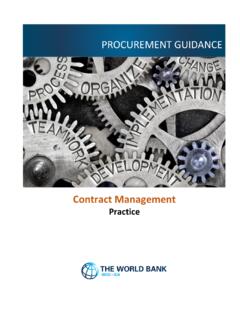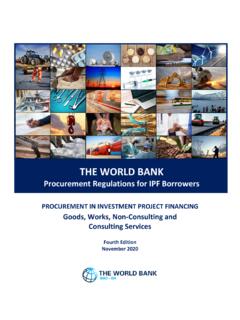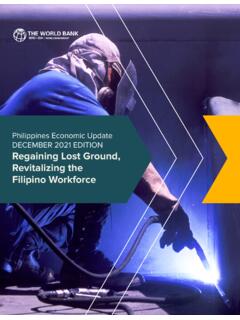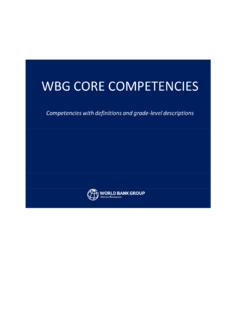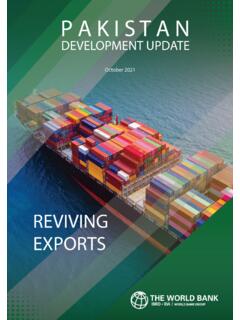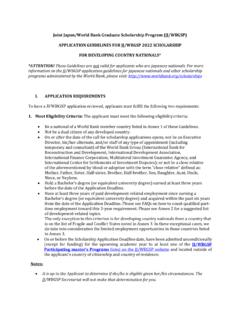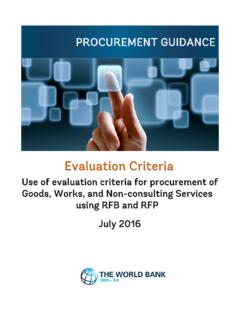Transcription of What is the relationship between politics, education ...
1 1 What is the relationship between politics, education reforms, and learning? Evidence from a new database and nine case studies Unika Shrestha Timothy P. Williams Samer Al-Samarrai Alies Van Geldermalsen Attiya Zaidi September 2019 Background Paper for World Development Report 2018 This background paper was prepared for the World Development Report 2018 LEARNING to Realize education s Promise. It is made available here to communicate the results of the Bank s work to the development community with the least possible delay. The manuscript of this paper therefore has not been prepared in accordance with the procedures appropriate to formally-edited texts. The findings, interpretations, and conclusions expressed in this paper do not necessarily reflect the views of The World Bank, its Board of Executive Directors, or the governments they represent.
2 The World Bank does not guarantee the accuracy of the data included in this work. The boundaries, colors, denominations, and other information shown on any map in this work do not imply any judgment on the part of The World Bank concerning the legal status of any territory or the endorsement or acceptance of such boundaries. 2 Abstract ..4 1. introduction ..6 Research questions .. 6 Strategy and organization of the paper .. 7 Summary of findings .. 7 2. Literature review: The technical and political challenges of improving learning outcomes .. 10 3. Episodes of learning improvement using cross-country data .. 13 Approach .. 13 Reforms database construction and description .. 14 Are improvements in learning associated with specific types of reforms? .. 18 Are trends in learning associated with changes in other conditions in education ?
3 20 Do economic conditions determine trends in learning? .. 23 Do political conditions determine trends in learning? .. 24 Summary .. 28 4. Studying cases of education reform: a synthesis of nine case studies .. 30 Approach .. 30 Information, metrics, and evidence .. 32 Coalitions and incentives .. 34 Innovation and agility .. 38 Summary .. 41 5. Discussion and conclusion .. 43 6. References .. 49 Annex A: Approach to identify episodes of sustained change in learning outcomes .. 58 Annex B: Country case studies .. 62 Country case 1: Improving funding and monitoring in Brazil .. 62 Country case 2: Passing Chile s pay-for-performance reforms, 1995 2005 .. 74 Country case 3: England s 2007 National Literacy 84 Country case 4: Teacher reforms in Peru, 2007 2012 .. 91 Country case 5: Big Results Now education (BRNEd) program in Tanzania, 2012 2016.
4 97 Country case 6: Aligning curriculum reforms in South Africa .. 105 Country case 7: Implementing primary education reforms in Bangladesh, 2004 2015 .. 112 Country case 8: Implementing teacher certification reform in Indonesia .. 120 Country case 9: Implementing accountability reforms in Mexico over two decades .. 127 3 4 Abstract Improving learning outcomes at scale is not just a matter of scaling up. It also entails attending to the technical and political complexities that shape education reforms. In this study, we draw on country-level quantitative and qualitative data to study the systemic factors that contribute to improved learning or cause declines. We approached this study through three activities. First, we established a database of education reforms and learning trends for 76 countries, enabling us to then examine the relationship between reform type and trends in learning outcomes.
5 Second, using this database, we examined the relationship between education system characteristics, political and economic factors, and episodes of sustained improvements or regressions in learning. Third, we prepared case studies for nine countries from the database that helped show different themes concerning the politics of education quality reforms. We then synthesized our findings to identify trends in strategies for deploying information, working with coalitions, and creating opportunities for strategic change. Findings from the database did not establish strong correlations with indicators of the economic and political conditions generally believed to have an effect on learning. Across most countries, the type of reforms introduced during periods of sustained learning improvements versus periods of decline did not differ systematically.
6 Expansion in primary or secondary education access was not consistently correlated with trends in learning; however, lagged improvements in pre-primary enrollment was correlated with a greater probability of sustained learning improvements. The findings also showed that changes in government spending on education was not strongly correlated with long-term learning trends. Moreover, neither economic growth during the episode nor lagged growth was correlated with learning trends. However, there was some suggestive relationship between accelerated growth and learning. In the case of political conditions, level of democracy failed to predict whether learning improved or declined. Episodes with the biggest improvements were more likely to begin in nondemocratic countries.
7 However, there was some relationship between increased democratization (transition to a more democratic political regime) within countries and learning improvement. Case study findings illustrated the complexities that shaped the ability of governments to deliver education reforms to improve quality. Cases of successful reforms and improved learning were characterized by governments whose decision-making and messaging were driven by information and learning metrics. These metrics used information to make the case for necessary reforms, provided incentives to improve local school systems and teacher quality, and established public accountability through a more informed citizenry. Accountability measures included international assessments, examinations, literacy rates, or school rankings.
8 Coalitions and political incentives took different forms. The case study findings also showed that the countries most effective in introducing and sustaining reforms considered the needs of various stakeholders at different levels of government and civil society. Those that failed to get the buy-in of a key group at the outset, , teachers unions, faced difficulties in implementing reforms, even if leaders were able to push through a policy reform. Effective communication strategy was also essential. The state needed to take control of the policy 5 reform s core message to prevent misinformation by competing interest groups. Effective reforms were focused and flexible. Policies were effective if they had a clear direction and could also be changed and even re-envisioned over time. Successful reforms were not necessarily contingent on charismatic leadership (though this could help).
9 Sequencing popular reforms with those less likely to be supported helped to increase acceptance of less popular reforms. Reforms built on one another over a longer period of time, gradually adding greater levels of sophistication and nuance into the system in a way that slowly improved learning outcomes. In conclusion, our study findings suggest that it is not any one component in education , economic system, or form of governance that is likely to improve learning. Rather, regardless of form, all technical inputs and political considerations must be coherent and aligned toward improved learning. Study findings and their implications must be read as exploratory. However, by offering some simple associations and hypothesizing the relationships of variables, the study offers a helpful perspective that can complement other recent efforts to understand the relationship between politics and quality reforms.
10 6 1. introduction In many developing countries, access to basic education has surged, but learning has not kept pace. Half of the 250 million children who cannot read, write, or do math go to The lack of quality is concerning for many reasons. education is considered a social good, a basic right, and a cornerstone for broader social and economic Quality education has been shown to be a better indicator of economic growth than the number of years of school That so many children are in school but fail to acquire basic skills and competencies establishes a learning crisis, one with powerful socioeconomic and political dimensions and effects. Ending the learning crisis will require effective use of the growing knowledge base on interventions that have improved learning.
